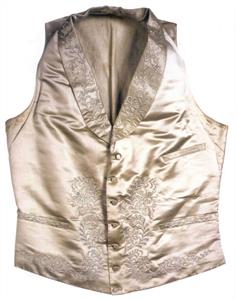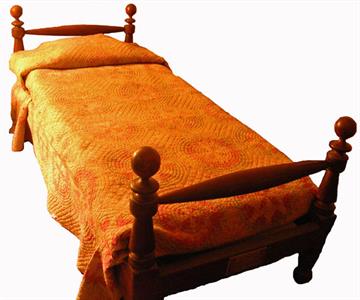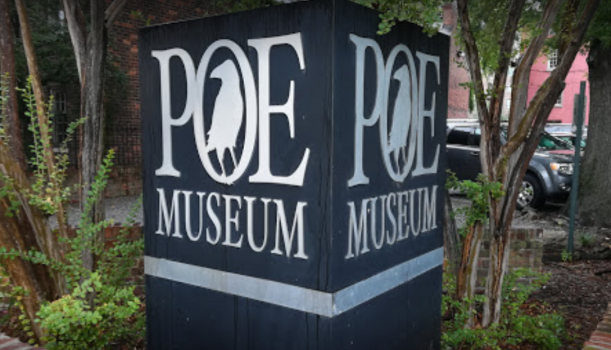
I’m sure we’re all familiar with the phrase from the Indiana Jones movies- That belongs in a Museum! In the following Six Questions with Chris Semtner, Curator of The Poe Museum, Chris generously shares with us some of the many treasures held there. Plus! In a final bonus question, Chris mentions some ‘lost treasures’ the Museum would love to find! Might you be able to help them find a lost treasure- THAT belongs in a Museum!
Let’s get to the Six Q’s (and bonus) with Chris ……. enjoy! (Also remember to follow The Poe Museum on Facebook, Twitter, or YouTube)

- 1Q) When did you start working with the Poe Museum. Can you share some of its historical background?
I started working here twenty years ago. The Poe Museum turned 98 this past April, so it is nearly a century old. At the time of its founding, it was the first literary museum in Virginia. It began with a group of artists, writers, historians, and preservationists who thought Poe deserved to be remembered in his hometown. This group was dismayed to see his childhood homes and the magazine office where he used to work being demolished, and they could not round up enough public support to get a statue of Poe built here. When his office was demolished, they saved the building materials, brought them to an empty lot down the street, and recreated the garden from one of Poe’s poems out of them.
The idea was that visitors would be stepping inside of one of Poe’s poems. They soon brought building materials–including the staircase–from one of Poe’s homes, and constructed one of the Poe Museum’s buildings out of it. In all, the Poe Museum consists of four buildings (dating from 1754 to 1927) surrounding a central garden. Other gardens were added to recreate the settings of some of Poe’s stories. Thanks to the generosity of several descendants of Poe’s relatives and friends, the museum accepted donations of some important Poe artifacts that would form the core of the museum’s collection. Now the museum has the world’s finest collection of Poe artifacts and memorabilia.
- 2Q) What do you enjoy most about working at the museum?
There are many great things about working at the Poe Museum, but one of them would have to be the people we meet here. Every year, the museum welcomes guests from all 50 states and at least 33 different countries, and most of them have had some kind of personal experience with Poe’s works. Maybe they were terrified by his works when they read them for class in middle school. In one case, a guest told me they learned to read English by reading Poe’s works, and another guest told me they had to read Poe’s works in secret in the USSR and that their Poe club was actually raided by the KGB, which probably suspected them of being spies. I can’t confirm that last story. We’re all part of a big Poe family, and it’s fascinating to meet so many people who have been inspired by him to create their own works in film, visual art, dance, music, and writing.
- 3Q) Do you feel there is one exhibit or artifact that the museum is most known for? Can you share some interesting facts about it?
I always tell people to look out for Poe’s socks. The Poe Museum is the only place you can see any of Poe’s clothing. Here you’ll find his waistcoat, socks, walking stick, nail file, penknife, chair, and the kind of personal possessions that really make him relatable. These pieces take history off the page or screen and make it tangibly “real.” They remind us that historical figures were people just like us who walked the same streets we are walking. Poe’s socks really epitomize this message. They have been repaired multiple times, showing us the wear and tear they went through in Poe’s day. His waistcoat is also a very nice piece. Made of silk and elaborately embroidered, it was obviously an expensive piece that the impoverished Poe could scarcely have afforded. Even people in his day wondered how he could afford such nice clothes. But he needed to wear impressive clothes when he gave his readings and lectures. At the end of his life, he was earning more from his performances than he was for publishing his works. He simply needed to look his best when appearing on stage in front of thousands of people. When you look a little closer, you can see that, like the socks, the waistcoat had seen better days.
As far as the socks’ history is concerned, they and some other articles of Poe’s clothing were in a trunk that went to Poe’s mother-in-law after his death. She left it with her niece, and the trunk passed down to her granddaughter, whose granddaughter gave the socks and waistcoat to the Poe Museum.

- 4Q) Is there some often forgotten item that shouldn’t be missed when visiting?
Some of the most intriguing artifacts in the museum are among the tiniest pieces in the collection. Take, for instance, the lock of Poe’s hair. It was cut after Poe’s death by the man who carried Poe to the hospital where he spent his final days. That same man, Joseph Evans Snodgrass, was one of only seven people to attend Poe’s funeral.
If you visit this year, you might also see a piece of Poe’s original coffin. Twenty-six years after his death, some of Poe’s admirers moved his remains to a more prominent location in the cemetery and finally placed a long-overdue monument over him. As they were moving the coffin, it fell apart, and everybody got a last look at Poe. Some of the witnesses grabbed pieces of that crumbling coffin, and we have one of them on display.
- 5Q) What do you feel is the most valuable ‘treasure’ of the museum? It might not be a monetary value, but of a historical value or even sentimental?
Most of the items here are irreplaceable, so it is difficult to put a value on them. The manuscripts, daguerreotypes, and first editions probably fetch the highest prices at auction, but I’d have to say that Poe’s boyhood bed is one of the greatest treasures in the collection. This is where little Eddie used to sleep, “dreaming dreams no mortal ever dared to dream before…” Imagine how many of the nightmares he had in that bed that, decades later, inspired his classic terror tales. One of Poe’s childhood friends, John Hamilton Mackenzie, once told a biographer that young Poe’s greatest fear was awakening in bed at night to see a face watching him from the darkness. I wonder if that image could have inspired “The Tell-Tale Heart,” a story which takes place in a darkened bedroom as the victim lies in just such a bed.

- 6Q) Is there any advice you would have for those wanting to visit? Are there best times of the day, or days of the week to come? How long should visitors allow on their schedules to explore the fascinating exhibits? Anything else?
The Poe Museum is open every day but Monday. Weekdays are a good time to visit because they are less crowded than weekends. The garden is green all year, and there is always something blooming. But the best time to see the most blooms is in the spring. Also, when you visit, be sure to give yourself about an hour to see the exhibits and another half hour to play with the Poe Museum Cats, Edgar and Pluto.
- BONUS QUESTION: Is there an item, a treasure so to speak, that the Museum, is on the lookout for? Might it be out there for someone to find?’
There are a couple lost treasures we would like to find. One is the last daguerreotype ever taken of Poe. He sat for it at Pratt’s Daguerrean Studio in Richmond a few weeks before his death. After Poe’s death, it belonged to Elmira Royster Shelton, the woman to whom he was engaged at the end of his life. It ended up with Poe collector Robert Lee Traylor, who died in 1905. I’ve met some of his descendants over the years, but, even though one of them owned some turn-of-the-century photographs of it, nobody seemed to know what happened to the original. Although it was seriously damaged in a cleaning attempt, the daguerreotype remains an important document of Poe’s final days and the association with his last fiancee, who was a Richmonder, makes it especially appealing to us in Richmond.
Poe is also known to have sketched portraits of his girlfriends in his early years. He even mentioned one of the sketches in a letter. We do not know what became of them. The Poe Museum owns a 1920s hand-drawn copy of a drawing a teenaged Poe did of his first fiancee (and later his last fiancee) Elmira Royster, but the original is missing. It was about the size of a silver dollar, so it could have ended up just about anywhere. The sad part is that the Poe Museum’s copy was drawn by a mediocre artist, so there is no telling how accurate a copy it is. There were three well-known fake Poe drawings (supposedly depicting Poe, his wife, and Elmira) that turned up in the 1930s, but no original artwork is currently located. A few paintings signed “POE” came on the market over the years, and the Poe Museum even owns one of them, even though a faker obviously wrote the name on a painting that was already old. We also own a small watercolor said to have been done by Poe and which might have his signature on the back, but there is no evidence to support an attribution to Poe. It would be nice to acquire a well-documented, authentic portfolio of Poe’s sketches, but how would you confirm they are his work if there are no authenticated Poe drawings to compare them to?
What an awesome six questions! Thanks so much to Chris for participating in the first of the series. If you happen to be inspired to visit the museum from the Six Q- please let them know that You got your Quest on from MW and these Six Q’s with Chris!
So much is out there to explore! Always Treasure the Adventure!
.


